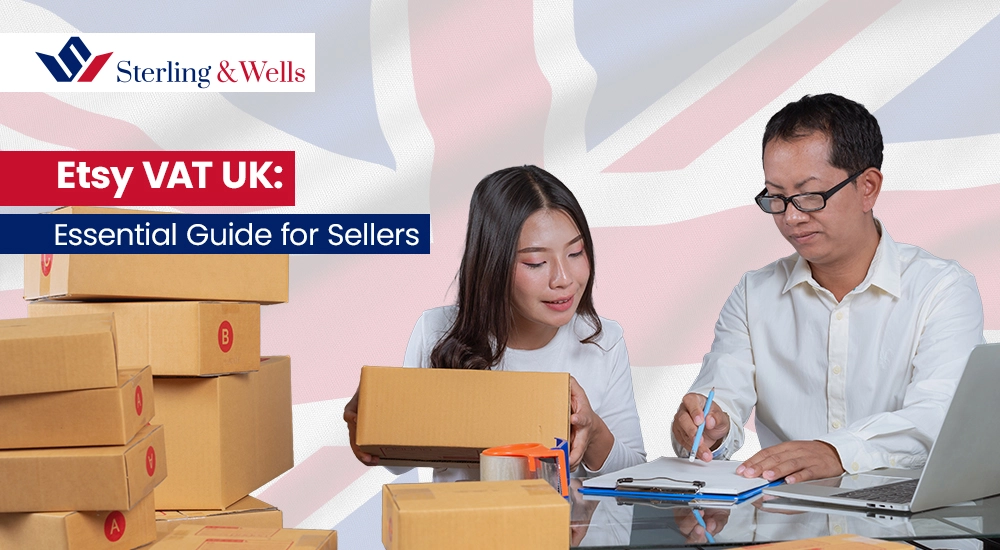Etsy VAT UK: Essential Guide for Sellers

Selling through Etsy to UK customers comes with specific VAT responsibilities. Whether you’re a UK-based artisan or an international entrepreneur, understanding how Etsy VAT UK applies is key to staying compliant and profitable.
This guide explains how VAT registration, collection, fees, imports, and reporting work when using Etsy in the UK.
UK VAT Registration for Etsy Sellers
If you’re selling to UK consumers via Etsy, HMRC generally considers you to be making taxable supplies in the UK—even if you’re based outside the UK. This means you’ll likely need to register for VAT in UK, especially if your sales are B2C.
In summary:
- UK VAT registration is required for most non-UK sellers selling to UK consumers. The threshold is effectively £0 for overseas sellers.
- B2B sales may be exempt if you collect valid UK VAT numbers from your buyers.
- Once registered, you must add your VAT number to your Etsy account, so it shows on your shop listings and invoices.
HMRC’s marketplace rules apply to Etsy just like Amazon or eBay. If you store goods in the UK or routinely serve UK customers, registration generally becomes mandatory regardless of your business location.
How Etsy Handles VAT on Sales
Etsy simplifies VAT compliance in many cases by collecting and remitting VAT on behalf of sellers—but only under certain conditions. Whether Etsy or you are responsible for VAT depends on the shipping origin, order value, and buyer location.
Here’s how it breaks down:
Orders shipped from outside the UK and valued ≤ £135
Etsy collects and remits UK VAT to HMRC. You receive the payout net of fees and VAT, and do not need to charge VAT yourself.
Orders shipped from outside the UK and valued > £135
Etsy does not collect VAT. The buyer pays import VAT upon delivery if they are considered as the importer. If the overseas seller is acting as an importer, such seller are making onwards taxable supplies in the UK and must register for UK VAT.
Goods already in the UK (regardless of seller location):
Etsy collects VAT on all sales made to unregistered customer or businesses, and you may not need to charge VAT separately if Etsy handles it.
It’s important to remember even if Etsy collects UK VAT on your behalf, you may still need to be VAT registered if your overall activities trigger HMRC’s requirements.
Practical Scenarios for Etsy VAT in UK
Understanding how the Etsy VAT UK rules apply in real life can help you plan better:
- Example 1
You sell a £50 product from the US to a UK buyer.
Etsy collects £10 VAT (20%) at checkout, remits it to HMRC, and pays you the net amount after fees.
- Example 2
You sell a £200 product from the US.
Etsy doesn’t collect VAT; the buyer pays import VAT when the parcel arrives in the UK.
- Example 3
You’re an EU seller shipping a UK-made product to a UK customer.
This is a domestic supply. Etsy won’t collect VAT. You must include VAT in your product price and remit it via your VAT return.
VAT on Etsy Fees and Input Tax
Etsy charges several types of fees—listing, transaction, processing, and subscription fees. If you’re using a UK account or located in the UK, these fees typically include UK VAT (20%).
As a VAT-registered seller:
- You can reclaim the VAT on these service fees as input tax on your VAT return.
- Always download and keep your Etsy invoices for accounting purposes.
- Although Etsy may handle VAT on your sales, their service fees are still your business expenses, and you remain responsible for them.
Some overseas sellers report complications reclaiming VAT on Etsy fees, but HMRC generally allows recovery if the service is “used and enjoyed” in the UK.
Import VAT and Postponed VAT Accounting (PVA)
If you’re shipping goods into the UK, import VAT applies just like it would with other platforms. However, Postponed VAT Accounting (PVA) can help you manage this more efficiently.
- With PVA, you don’t pay VAT at the border. Instead, you declare it on your VAT return.
- This improves cash flow and keeps your import costs predictable.
- If you’re using couriers or third-party fulfillment services, ask them to enable PVA when arranging shipments.
Etsy VAT Reporting, Invoicing, and Digital Records
Etsy online marketplace provides useful reports and tools, but you must still ensure your own records and invoices meet HMRC’s VAT rules.
Best practices include:
- When Etsy collects VAT, download their VAT statements or invoices as supporting evidence.
- For sales where you’re responsible for VAT, ensure your own invoices meet UK VAT invoice requirements.
- Use digital accounting software like Xero or QuickBooks to maintain MTD-compliant records.
- File your UK VAT returns on time and reconcile your Etsy sales, imports, and fees regularly.
Conclusion
Managing Etsy VAT in UK doesn’t have to be complicated. By understanding when to register, how Etsy handles VAT collection, and what your responsibilities are for fees, imports, and reporting, you can turn VAT compliance into a streamlined part of your business. Whether you’re selling handmade jewellery from Germany or vintage clothing from the US, taking a proactive approach to VAT will protect your profits and keep your business on the right side of HMRC.
Selling on Etsy? Understand Your VAT Obligations with Sterling & Wells
Our team of experts is here to provide clear guidance and practical insights to help you stay compliant with UK VAT rules as an Etsy seller. Your journey towards stress-free online selling and full VAT compliance starts with a conversation.
Prasun
Prasun Shrestha is a specialist in accounting and taxation and has served numerous clients based inside and outside UK achieve regulatory compliance and optimal performance.